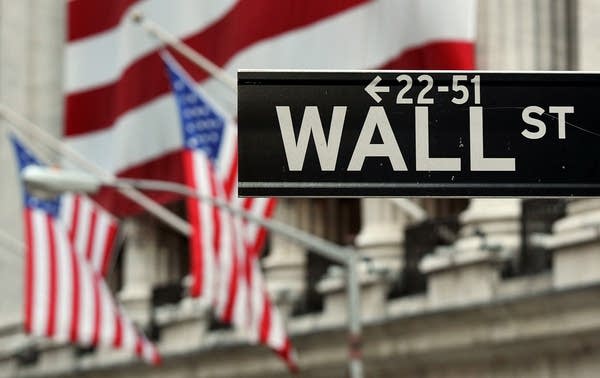Dow ends above 14,000 for 1st time since Oct. 2007
Go Deeper.
Create an account or log in to save stories.
Like this?
Thanks for liking this story! We have added it to a list of your favorite stories.

CHRISTINA REXRODE, Associated Press
NEW YORK (AP) — The Dow closed above 14,000 on Friday for the first time in more than five years.
Sure, it was just a number on a board. But it was enough to raise the hopes of some investors and cause others concern about an overheated market. And it brought reminders of a different era, back before the financial crisis rocked the world economy.
The Dow Jones industrial average, a stock market index that is supposed to be a benchmark for how the entire market is faring, had been rising fairly steadily for about a month. On Friday, strong auto sales and optimism about U.S. jobs pushed it over the mark. The Dow is now just 155 points away from its highest close ever.
Turn Up Your Support
MPR News helps you turn down the noise and build shared understanding. Turn up your support for this public resource and keep trusted journalism accessible to all.
"There's a newfound enthusiasm for the equity market," said Jim Russell, regional investment director at U.S. Bank Wealth Management in Minneapolis.
But market watchers were divided over what the Dow milestone -- or even what a potential new all-time high -- really means. To some, it's an important booster to hearts and minds, making investors feel optimistic and thus more willing to bet on the market.
"The Dow touching 14,000, it matters psychologically,'' said Peter Cardillo, chief market economist at Rockwell Global Capital in New York. "It attracts smaller investors.''
"It's good trivia to talk about on TV and the radio. It's meaningless to the average professional."
And those investors, until recently, had been shying away from stocks. Since April 2011, investors have pulled more cash out of U.S. stock mutual funds than they've put in, according to the Investment Company Institute. In the past three weeks, though, that trend has reversed, which could make January the first month in nearly two years where stock-focused funds had a net inflow.
To others, though, Dow 14,000 is nothing but a number, a sign more of how traders feel than of the economy. And it's not even the best number on the board, some traders say.
Professional investors usually pay more heed to the Standard & Poor's main index, which tracks 500 companies compared to the Dow's 30. The Dow garners attention, they say, because it's more familiar to the general public.
Joe Gordon, managing partner at Gordon Asset Management in North Carolina, wasn't celebrating Friday. He thinks the gains won't last. The fact that small investors are finally piling back in the stock market, he said, is not a reason for optimism but a sign that it's getting overhyped and due to fall.
After the Dow hit its all-time record in 2007, it fell almost steadily for the next year and a half. It lost more than half its value before starting to tick back up again.
"It is good trivia to talk about on television and the radio,'' Gordon said, referring to the 14,000 mark. "It's meaningless to the average professional.'' And for workers still unemployed by the financial crisis, he said, "it really means nothing to them.''
If there is dissent over what Dow 14,000 signifies, what's undeniable is that it's a rarefied event. Before Friday, the Dow had closed above 14,000 just nine times in its history. The first time was in July 2007; the rest were in October of that year.
The last time the Dow closed that mark was Oct. 12, 2007, when it settled at 14,093.08. It had reached its all-time record, 14,164.53, three days before that.
For the average investor, that was all back when the stock market still seemed like a party. Housing prices were starting to ebb but hadn't cratered. Jobs were abundant, with unemployment at 4.7 percent -- compared to 7.9 percent now. Lehman Brothers still existed. So did Bear Stearns, Wachovia and Washington Mutual.
The Dow ended Friday 149.21 points higher to 14,009.79. The other indexes were also up. The S&P 500 rose 15.06 to 1,513.17. The Nasdaq composite index was up 36.97 to 3,179.10.
Auto sales helped. Toyota, Ford, GM and Chrysler all reported double-digit gains for January.
The government jobs report that pushed stocks forward was mixed, but traders chose to focus on the positive. The U.S. said it added 157,000 jobs in January, which was in line with expectations. Unemployment inched up to 7.9 percent from 7.8 percent in December. Many economists, though, were encouraged because the government now says that hiring over the past year was higher than originally thought.
The jobs number is based on a survey of employers. The unemployment rate is based on a separate survey of households, which is why they can diverge.
Among stocks making big moves:
• Drugmaker Merck fell more than 3 percent, down $1.42 to $41.83. Its fourth-quarter profit suffered because of competition from generic medicines against its blockbuster allergy drug Singulair.
• Insurance company MetLife rose more than 2 percent, up 86 cents to $38.20, after saying it plans to buy the largest private pension fund administrator in Chile.
• Zoetis, an animal health business that Pfizer just spun off, made its debut on the stock market. It shot up 19 percent, rising $5.01 to $31.01.
____
AP Business Writer Matthew Craft contributed to this report.
Dear reader,
Your voice matters. And we want to hear it.
Will you help shape the future of Minnesota Public Radio by taking our short Listener Survey?
It only takes a few minutes, and your input helps us serve you better—whether it’s news, culture, or the conversations that matter most to Minnesotans.




